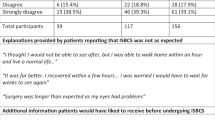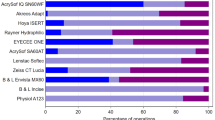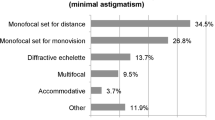Abstract
Objectives
To investigate patient understanding of, and attitudes to, premium (toric, extended depth of focus/multifocal) intraocular lenses (premIOLs) in public health sector patients undergoing cataract surgery (CS) in the UK.
Methods
A 12 question survey with Likert scale questions was designed, to assess patient attitudes to post-operative spectacle dependence, refractive target and desirability of spectacle independence whilst considering possible complications of dysphotopsias and need for premIOL exchange/adjustment.
Results
360 surveys were collected. CS had not been performed in 66.5%. Separate spectacles were worn for reading and distance in 28.8%, 19.2% had varifocals, 11.2% bifocals, 22.9% reading glasses only and 1.6% computer glasses only. Contact lenses were not worn in 95.7%. Only 41.6% were drivers. Most patients (85.8%) did not mind wearing glasses after CS, with 78.9% preferring reading glasses, compared with 29.7% preferring distance glasses. Most patients (75.3%) were not familiar with premIOLs, with 58.9% not willing to consider them in the context of a 2% risk of debilitating dysphotopsia and 54.2% rejecting a 5% risk of second surgery.
Conclusions
There is a lack of awareness of premIOLs in public health sector (NHS) patients in the UK, suggesting limitations in the “fully informed” consent process for CS. Most NHS CS patients are currently willing to wear spectacles after CS, especially reading glasses. There is reluctance in such patients to consider premIOLs on a background of small risks of debilitating dysphotopsias and increased risks of a second operation.
This is a preview of subscription content, access via your institution
Access options
Subscribe to this journal
Receive 18 print issues and online access
$259.00 per year
only $14.39 per issue
Buy this article
- Purchase on Springer Link
- Instant access to full article PDF
Prices may be subject to local taxes which are calculated during checkout
Similar content being viewed by others
Data availability
The datasets generated by the survey research during and/or analysed during the current study are available on application to the corresponding author.
References
World report on vision. Geneva: World Health Organization; 2019. Licence: CC BY-NC-SA 3.0 IGO. https://www.who.int/publications/i/item/9789241516570. Accessed Sept 2022.
Minassian DC, Reidy A. Future sight loss UK (2): an epidemiological and economic model for sight loss in the decade 2010-2020. 2009;130:1 http://www.rnib.org.uk/sites/default/files/FSUK_2.Pdf. Accessed Sept 2022.
Eurostat—Surgical operations and procedures statistics. https://ec.europa.eu/eurostat/statistics-explained/index.php?title=Surgical_operations_and_procedures_statistics. Accessed Sept 2022.
Henry P, Donachie J & Buchan JC. Year 6 annual report-the fifth prospective report of the National Ophthalmology Database Audit National Ophthalmology Database Audituk 2 NOD Audit Sixth Annual Report-Fifth Prospective Audit Year Report. 2022.
Day AC, Donachie PH, Sparrow JM, Johnston RL. Royal College of Ophthalmologists’ National Ophthalmology Database. The Royal College of Ophthalmologists’ National Ophthalmology Database study of cataract surgery: report 1, visual outcomes and complications. Eye. 2015;29:552–60. https://doi.org/10.1038/eye.2015.3.
Pager CK. Expectations and outcomes in cataract surgery: a prospective test of 2 models of satisfaction. Arch Ophthalmol. 2004;122:1788–92. https://doi.org/10.1001/archopht.122.12.1788.
Cao K, Friedman DS, Jin S, Yusufu M, Zhang J, Wang J, et al. Multifocal versus monofocal intraocular lenses for age-related cataract patients: a system review and meta-analysis based on randomized controlled trials. Surv Ophthalmol. 2019;64:647–58. https://doi.org/10.1016/j.survophthal.2019.02.012.
NICE. Cataracts in adults: management. 2017. https://www.nice.org.uk/guidance/ng77. Accessed Sept 2022.
Ferrer-Blasco T, Montés-Micó R, Peixoto-de-Matos SC, González-Méijome JM, Cerviño A. Prevalence of corneal astigmatism before cataract surgery. J Cataract Refract Surg. 2009;35:70–5.
Hoffmann PC, Hütz WW. Analysis of biometry and prevalence data for corneal astigmatism in 23,239 eyes. J Cataract Refract Surg. 2010;36:1479–85.
Khan MI, Muhtaseb M. Prevalence of corneal astigmatism in patients having routine cataract surgery at a teaching hospital in the United Kingdom. J Cataract Refract Surg. 2011;37:1751–5.
Tahhan N, Papas E, Fricke TR, Frick KR, Holden BA. Utility and uncorrected refractive error. Ophthalmology. 2013;120:1736–44.
Nanavaty MA, Bedi KK, Ali S, Holmes M, Rajak S. Toric intraocular lenses versus peripheral corneal relaxing incisions for astigmatism between 0.75 and 2.5 diopters during cataract surgery. Am J Ophthalmol. 2017;180:165–77.
Titiyal JS, Khatik M, Sharma N, Sehra Sri V, Maharana PK, Ghatak U, et al. Toric intraocular lens implantation versus astigmatic keratotomy to correct astigmatism during phacoemulsification. J Cataract Refract Surg. 2014;40:741–7. https://doi.org/10.1016/j.jcrs.2013.10.036.
Lam DK, Chow VW, Ye C, Ng PK, Wang Z, Jhanji V. Comparative evaluation of aspheric toric intraocular lens implantation and limbal relaxing incisions in eyes with cataracts and ≤3 dioptres of astigmatism. Br J Ophthalmol. 2016;100:258–62. https://doi.org/10.1136/bjophthalmol-2014-306587. Epub 2015 Jun 18. PMID: 26089214
Mendicute J, Irigoyen C, Ruiz M, Illarramendi I, Ferrer-Blasco T, Montés-Micó R. Toric intraocular lens versus opposite clear corneal incisions to correct astigmatism in eyes having cataract surgery. J Cataract Refract Surg. 2009;35:451–8. https://doi.org/10.1016/j.jcrs.2008.11.043. PMID: 19251137
Mingo-Botín D, Muñoz-Negrete FJ, Won Kim HR, Morcillo-Laiz R, Rebolleda G, Oblanca N. Comparison of toric intraocular lenses and peripheral corneal relaxing incisions to treat astigmatism during cataract surgery. J Cataract Refract Surg. 2010;36:1700–8. https://doi.org/10.1016/j.jcrs.2010.04.043. PMID: 20870116
Hirnschall N, Gangwani V, Crnej A, Koshy J, Maurino V, Findl O. Correction of moderate corneal astigmatism during cataract surgery: toric intraocular lens versus peripheral corneal relaxing incisions. J Cataract Refract Surg. 2014;40:354–61. https://doi.org/10.1016/j.jcrs.2013.08.049.
Poll JT, Wang L, Koch DD, Weikert MP. Correction of astigmatism during cataract surgery: toric intraocular lens compared to peripheral corneal relaxing incisions. J Refract Surg. 2011;27:165–71.
Henry P, Donachie J, Sparrow JM & Buchan JC. Feasibility study of post-cataract posterior capsule opacification national ophthalmology database audit. 2021. https://www.nodaudit.org.uk/u/docs/20/rijbxkcubs/RCOphth%20NOD%20PCO%20Report%202021.pdf. Accessed Sept 2022.
NTS0201: Full car driving licence holders by age and gender: England (with chart). https://view.officeapps.live.com/op/view.aspx?src=https%3A%2F%2Fassets.publishing.service.gov.uk%2Fgovernment%2Fuploads%2Fsystem%2Fuploads%2Fattachment_data%2Ffile%2F1101183%2Fnts0201.ods&wdOrigin=BROWSELINK. Accessed Sept 2022.
Centre for London. Car ownership, use and parking in London. https://www.centreforlondon.org/reader/parking-kerbside-mangement/chapter-1/#travel-habits-are-changing-but-modal-shift-is-slow. Accessed Sept 2022.
Association of Contact Lens Manufacturers (ACLM) statistics 2016. https://www.abdo.org.uk/news/aclm-2016-contact-lens-statistics/#:~:text=In%20total%20there%20are%20approximately%204.2%20million%20contact,and%201.8%20million%20people%20use%20frequent%20replacement%20lenses. Accessed Sept 2022.
Morgan P. Trends in UK contact lens prescribing 2021. Optician. 2021. https://www.opticianonline.net/opinion/trends-in-uk-contact-lens-prescribing-2021. Accessed Sept 2022.
NHS. NHS Cataract surgery advice. https://www.nhs.uk/conditions/cataract-surgery/ Accessed Sept 2022.
Wang SY, Hernandez-Boussard T, Chang RT, Pershing S. Understanding patient attitudes toward multifocal intraocular lenses in online medical forums through sentiment analysis. Stud Health Technol Inform. 2019;264:1378–82.
Walker JA. What is the effect of preoperative information on patient satisfaction? Br J Nurs. 2007;16:27–32.
Bhan A, Dave D, Vernon SA, Bhan K, Bhargava J, Goodwin H. Risk management strategies following analysis of cataract negligence claims. Eye. 2005;19:264–8.
Elder MJ, Suter A. What patients want to know before they have cataract surgery. Br J Ophthalmol. 2004;88:331–2.
Lockey J. The provision of information for patients prior to cataract surgery. Br J Nurs. 2009;18:1207–11. https://doi.org/10.12968/bjon.2009.18.19.44833
Cataract. Patient Information Moorfields Eye Hospital NHS Trust. https://www.moorfields.nhs.uk/sites/default/files/Cataract%20service_1.pdf Accessed Sept 2022.
Acknowledgements
We are grateful for a non-commercial grant from J&J inc. which helped partially fund this study.
Author information
Authors and Affiliations
Contributions
KN, LD and DO’B designed the questionnaire with contributions from MB, SL and EA. Data were collected by all authors. AJ analysed the data and wrote the paper with DO’B. The project was overseen by DO’B.
Corresponding author
Ethics declarations
Competing interests
DO’B holds non-commercial research grants with Rayner Ltd. and J&J Inc and is a consultant for Sparca Inc. The other authors declare no competing interests.
Additional information
Publisher’s note Springer Nature remains neutral with regard to jurisdictional claims in published maps and institutional affiliations.
Supplementary information
Rights and permissions
Springer Nature or its licensor (e.g. a society or other partner) holds exclusive rights to this article under a publishing agreement with the author(s) or other rightsholder(s); author self-archiving of the accepted manuscript version of this article is solely governed by the terms of such publishing agreement and applicable law.
About this article
Cite this article
Jameel, A., Dong, L., Lam, C.F.J. et al. Attitudes and understanding of premium intraocular lenses in cataract surgery: a public health sector patient survey. Eye 38, 76–81 (2024). https://doi.org/10.1038/s41433-023-02633-6
Received:
Revised:
Accepted:
Published:
Issue Date:
DOI: https://doi.org/10.1038/s41433-023-02633-6



